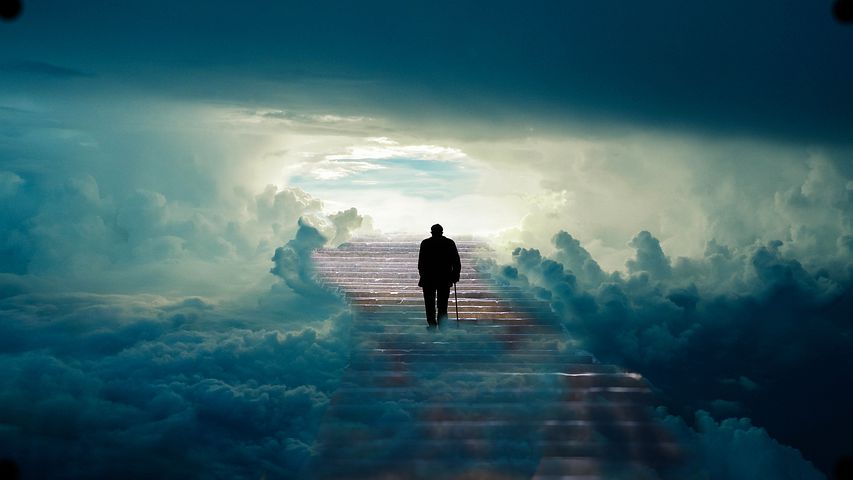Scientists gave an affirmative answer
Whether there is life after death? Dr. Stuart Hameroff of the University of Arizona spoke about a scientific theory that confirms the existence of both the afterlife and the immortal soul.
An American anesthesiologist announced this on the air of the Science TV channel, in the program “Through the Tunnel in Space.”
According to him, human souls are created from some material, “much more fundamental than neurons, from the very fabric of the universe.”
“I think that consciousness has always existed in the universe. Perhaps since the Big Bang,” says the professor.
According to him, when a person dies and the body is destroyed, the quantum information contained in microtubules (protein intracellular structures) is not destroyed, but spreads in space.
S. Hameroff believes that this is why people in a state of clinical death experience near-death experiences: for example, they see a bright light or feel that they are flying through some kind of tunnel.
When doctors bring them back to life, this quantum information that was in space returns to the body again, so the person remembers this unusual experience.
Some colleagues of S. Hameroff criticize his theory, but the scientist notes that they still have not been able to refute it.

Is there life after death
For the first time in history, physics and medicine, researchers and psychologists have joined forces to find a scientific answer to the question “Is there life after death?”
In preparation for the conference, the facts were carefully checked: scientific and documentary chronicles, research results and the experience of doctors were collected and subjected to an in-depth analysis.
Doctors in their practice often encounter such experiences of patients.
For the patient, the experience was shocking – for the first time she felt separate from the physical body! And for doctors, this is another case of thousands of similar ones.
The conference was not only looking for a scientific explanation for such experiences. We also searched for answers to a number of other questions:
- What does science say about the afterlife?
- How does science explain the memory of past lives?
- Where is our memory actually stored?
- Are there any facts that prove that reincarnation exists?
- In terms of physics, where is heaven and hell?
What does life after death look like?
When a person dies, not the whole organism immediately stops its vital activity.Biological processes continue in the corpse, since not all tissues yet “know” that they have become useless.
Systems turn off gradually, but after a fairly short time they all stop working. Even hair and nail cells, which according to a common misconception continue to grow in the dead, actually stop dividing shortly after death.
Peter Noble, Alexander Pozhitkov of the University of Washington in Seattle and their colleagues studied gene activity and organ function in zebrafish (Danio rerio) and house mice (Mus musculus) immediately after their death.
To do this, scientists estimated the number of transcripts – RNA molecules that are formed during transcription (DNA reading) and either transfer the information encoded in genes to the sites of protein synthesis (messenger RNA, mRNA) or regulate the activity of other genes (non-coding RNA).
An increase in the number of certain transcripts indicates that the corresponding gene has increased its activity.
Geneticists determined the concentration of various mRNA molecules in 43 zebrafish and in the liver and brain of 20 laboratory mice.
Measurements were taken several times at regular intervals for four days after the death of living beings.The results were then compared with those obtained at the time of their death.
As expected, mRNA concentration decreased over time, however, transcripts associated with 548 zebrafish genes and 515 mouse genes showed peaks in their numbers after the death of the animals.

What are the results
This result means that there is enough energy in the deceased organism for some genes to remain active for a long time, despite the death of the entire biological system.
According to Noble, the study showed that there are peculiar cycles of activity of certain genes that do not stop their work. At the same time, the rest of the DNA falls victim to chaos and decay.
Immediately after death, hundreds of genes with different functions wake up. For example, these include embryonic developmental genes that are normally turned off after birth, as well as genes that have been previously shown to be associated with cancer.
Their activity peaked 24 hours after death. Interestingly, similar processes can occur in humans.
For example, in 2013, scientists from the University of Granada showed that various genes, including those involved in heart muscle contraction and wound healing, remain active for up to 12 hours after death from multiple injuries, a heart attack, or asphyxiation.
So why do so many genes turn on after death?
Perhaps most of the genes become active because their main role is participation in the processes of wound healing and recovery of the body after serious injuries.
For example, during the death agony, physiological mechanisms are activated to maintain the functions of tissues and organs.
Similarly, after death, some cells may have enough energy to activate genes involved in inflammation. In other words, these cells “don’t know” that the damage is too great to fix, and the genes continue to blindly follow instructions.